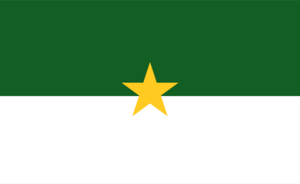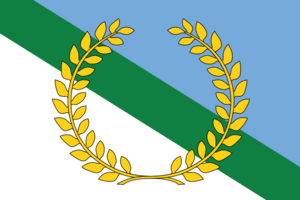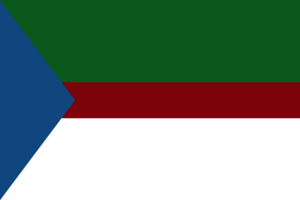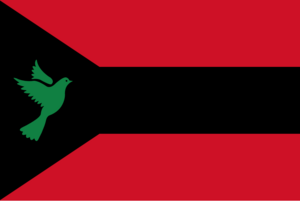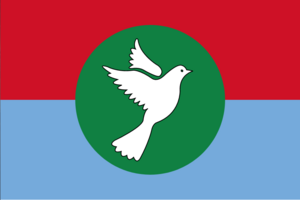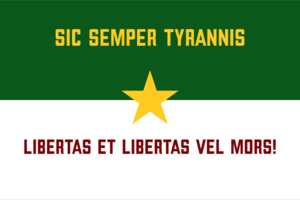Gaia
Gaia, the sole planetary body within the Galilei system, is one of the only Earth-like planets known to humanity. Gaia was historically an agricultural powerhouse, supplying upwards of a quarter of humanity's agricultural products before 2292. Today, in the aftermath of the Gaia Conflict, Gaia is a war-torn planet split between the occupying forces of the Sol Central Government and the Gilgamesh Colonial Confederation with only a tiny strip of land and the planetary capital of New Venice remaining under independent Gaian control.
Geography
Gaia is about one-tenth smaller than Earth, and its nitrogen-oxygen atmosphere is slightly thicker. This makes Gaia marginally warmer and more favorable to farming during all seasons.
Geographically, the planet has no oceans; however, several areas of the planet possess 'shot lakes,' large groupings of smaller lakes interconnected by streams and rivers. The planet’s largest body of water is Lake Cabot, a large round lake on the planet's equator.
Gaia is predominantly covered in vast, rolling plains, though the planet has several other notable geographical features. The Napoleon Mountains – a mountain range several hundred kilometers west of Lake Cabot – separates the Cabot region from the shot lakes, and the Tobruk Desert sits near the planet’s north pole.
Gaia does not possess ice caps. While the planet has a semblance of Earth-like seasons, temperatures are only known to fall below freezing in the mountains and desert regions, and Gaia’s overall climate is distinctly Mediterranean.
Scarred from several years of war and orbital bombardments, some areas of the planet have lost their ability to support heavy agriculture. Many Gaians fear that the Tobruk Desert may begin expanding in the coming years.
Modern Division
Gaian Administrative Area
Still under a military administration over a decade after the conflict, Southern Gaia holds no representation in the Solar Assembly and is run on the planetary level by an administrative council appointed from the Fourth Fleet and Army Group Cabot ranks. The council is still headed by Brigadier General Louis Montgomery, who has become the target of most public outrage. While the administrative council has made significant efforts to rebuild the region following the war (primarily out of security concerns), the region functions more like an occupied state than a member of the SCG, and Solar peacekeeping forces supplant civilian law enforcement in many areas. This continues to contribute to the tense political situation in the South, where politics are conducted at the municipal level, with pro-autonomy parties regularly in office.
Independent City of New Venice
Established as an international city-state with the Treaty of New Venice, New Venice remains a bastion of Gaian politics and independence on the shores of Lake Cabot. With the mayor holding total executive powers held in check by an elected fifteen-seat city council, the independent city functions much more like a government in exile than a city government, continuing to maintain public services across the planet, notably the issuance of passports, all on-planet diplomacy, and infrastructure. Gaians cannot be prosecuted for public statements within the city, and this loophole has been used to a great extent by many across both hemispheres to decry the situation many Gaians have found themselves in in the years following the conflict.
Protectorate of Gaia
The Protectorate of Gaia consists of Gaia’s Northern hemisphere, under GCC occupation. Northern Gaia holds no representation in the Confederation's Directory. While an elected parliament and Prime Minister run the Protectorate, its operations are directly beholden to a Governor General appointed by the Directory. Under the Governor General, the Protectorate government has prioritized the production of agricultural goods for the GCC, paying little heed to other issues. While the relative lack of oversight has granted Northern Gaians greater freedom than their Southern counterparts, post-war reconstruction has remained stagnant outside the agricultural sector, and many former urban areas remain in disrepair. Today, Gaian exports comprise almost a quarter of the GCC’s imported food supply.
The present Governor-General, Vice-Admiral Mira Novak, has held the post since the 2304 retirement of Vice-Admiral Lee. Her hands-off approach has left public opinion lukewarm at best, with most day-to-day matters left to the parliament. However, few Gaians have forgotten the brutal policing and orbital bombardments of the Gaia Conflict.
The Political Tinderbox
Compared to the past decade, Gaia is relatively stable – at least on the surface. As it stands, the planet as a whole is not in a position to change sides or suddenly erupt as an independent state without a sudden rallying factor. While Gaians might protest in the streets of Syracuse or New Madrid against different governments, the one unifying factor for any Gaian who survived the conflict is an absolute anti-war stance. The right spark – say, the threat of another conflict – and the planet stands to go off like a powder keg to ensure their own survival.
Notable Areas
Northern Gaia
New Madrid
New Madrid is the Administrative Capital of the North and the second most significant metropolis on the planet, situated amongst the ‘great shot lakes’; the New Madrid Prefecture encompasses the city of New Madrid and its many suburbs that wrap around the thousands of lakes within the Prefecture. New Madrid recently took control of the former Confederation Naval Yards, built by the ICCGN during the conflict as a resupply base; today, it is the largest public transit hub on the planet and often the first stop for travellers heading further into the GCC.
New Madrid is regarded by many in the SCG as one of the safest tourist destinations within the GCC. The city contains a vibrant entertainment district, with countless casinos and resorts on its many lakes.
GCNB Tobruk
Gilgamesh Confederation Naval Base Tobruk covers the western half of the Tobruk Desert, sitting at the north end of the Napoleon Mountain range, GCNB Tobruk is the only permanent posting for Confederation Naval Forces within the Galilei System and from where all Naval activity within the System is based from.
Venetian DMZ
New Venice
New Venice, the largest city on the planet and officially the capital of Gaia, is – in practice – the only remnant of independence on the planet. Established as an international city with the Treaty of New Venice, the mayor regularly mediates between the SCG and GCC.
Set on the southern shore of Lake Cabot, the city houses many governmental offices for both the North and South, as well as the SCG and GCC, resulting in the unique occurrence where members of the two rival superpowers' governments live and work in somewhat close quarters.
The New Venice Constabulary is the only armed force permitted within the city and DMZ as a whole, with all others (including Gaian civilians) forced to relinquish their weapons for the duration of their stay. Enforcement of this policy is limited outside the city itself, however, mainly owing to a lack of manpower.
The Strip
The Strip is the name of the 300-kilometre-wide DMZ that spans the planet’s equator, given to it by the Gaian populace. Not even a speedbump in the event of a conflict, the Strip is run by the government in New Venice with little oversight from either the North or South. Many strip residents cling fiercely to their independence, refusing to bend to Sol or the GCC; they are largely left to their own devices by the New Venice Constabulary, who are more concerned with enforcing the law in the capital.
Southern Gaia
Syracuse
Syracuse, renamed from New Syracuse in 2271, is the South’s largest city and its administrative capital. A manufacturing city before the Gaia Conflict, Syracuse has seen a boost in the industry since the division of the planet, with Sol encouraging a shift from agriculture to manufacturing. Syracuse houses many of the planet’s workshops for agricultural equipment, exported both to the North and off of the planet; it is quickly becoming one of the largest agrarian equipment exporters in human space.
Situated on the Catalonian River, the city offers less in the way of nightlife than its Northern brother; instead, the lights of cargo vessels are often the only thing illuminating the vast river during the night.
SCGDFB Cabot
SCG Defence Forces Base Cabot is the primary basing location for SCG PDF forces on the planet; unlike its Northern twin, DFB Cabot is situated an hour up the Catalonian River from Syracuse, with the area the base controls being industrial lands before the conflict, the land was quickly appropriated by the Fourth Fleet to be their embarkation point on the planet, with quick access to the civil populace when required.
Culture
- Most Gaians are tri-lingual, speaking the planet's native Iberian, Zurich Common, and Pan-Slavic.
- The South has a larger population and economy but is less stable than the North due to unrest and the continuation of the Military Administration.
- Native-born and naturalized Gaians are entitled to free transit of the planet and the right to bear arms. Northern Gaians are not eligible for service in the GCC’s military forces but are exempted from the GCC’s mandatory state service.
- People on Gaia can be broadly divided into four categories:
- Native Gaians: Gaians who were born on the Planet.
- Naturalized Gaians: Gaians who were not born on the planet but immigrated onto the planet before the Conflict and were afforded the rights of native Gaians due to their "naturalization by fire".
- Temporary Residents: People who live and work on Gaia temporarily, such as Colonial Guard or Army Group Cabot personnel who do not intend to remain on the planet.
- "The New Wave": New immigrants who have moved to the planet following the Conflict; these immigrants, particularly those of Core Solar origin, are sometimes seen as ‘taking advantage’ of the occupied plant.
- Gaian society has traditionally been very religious, with less than 20% of the population reporting being atheist or agnostic.
Character Tips
Most Gaians can clearly remember the conflict. Many are the people they are today because of it. Gaians are stubbornly attached to their homeworld, with Gaia not experiencing the exodus following the conflict that many Confederation planets saw, even though the planet was by far the most damaged – for most, Gaia is the only home they’ve ever known. They can remember everything quite clearly, and the memories of war are far more prevalent in the public consciousness than elsewhere in human space; you cannot go more than a few kilometres without passing some sign of the conflict, be it a silent memorial along the side of a road, a cratered field surrounding an abandoned farmstead, or the respectfully-maintained graveyards where civilians and combatants lay side by side.
Gaians remember it all and will continue to remember it for generations to come. Colonial Guard troops assigned to Galilei are hand-picked career personnel who understand the gravity of their duties. Along with the PDF troops of Army Group Cabot, they’ve come to understand that the glares and scorn they receive daily are rooted in an ever-present loathing of the fact that they are on the planet at all.
Flags
| Polity | Flag | Description |
|---|---|---|
| Pre-Conflict, New Venice, The Strip | Still extremely popular among the populace, this flag is commonly flown across the planet, with most still considering this flag the ‘correct’ Gaian flag. | |
| Gaian Administrative Area | Rarely seen outside of government property, this flag is only seen in the hands of the general public when it’s being burned during protests against the ongoing military occupation. | |
| Protectorate of Gaia | Similarly to its Southern brother, this flag suffers from the same lack of popularity as the South’s; however, it is popular among Independent immigrants, and is backed by a civilian government. | |
| New Madrid Prefecture | The addition of the dove in 2299 to this flag was considered controversial at the time. However, many have warmed to this flag over the years, being a common sight alongside Pre-conflict flags in the New Madrid Prefecture, or flown by fans at sports events. | |
| Syracuse Prefecture | Once again, a flag that has grown more popular over time, it’s common to see this flag flying across Syracuse and at sports events. | |
| Gaian ‘Rebel’ Flag | While variations of the ‘Rebel’ flag exist, its most common form is a pre-conflict banner with defiant text sown on; these flags are commonly flown during protests or as a replacement for the standard pre-conflict flag by more outspoken Gaians. |
History
The first sleeper ships arrived in the Galilei system in the 2130s, settling at the sites of what would become Gaia’s modern metropolises. By the middle of the century, these colonies had formed a loose planetary government based in New Venice.
Like other sleeper colonies, Galilei would not re-establish contact with Sol until the late 22nd century. By that time, the Terran Commonwealth was embroiled in its war against the Ares Confederation. When the Sol Central Government finally rose from the Commonwealth’s ashes, Sol was in no shape to look towards other systems – with the SCG turning inward, Gaia would retain its independence for the next sixty years. Between 2230 and 2270, Gaia settled into limited trade arrangements with nearby systems; agricultural exports (particularly exports to the newly-expanding Gilgamesh) formed the bulk of Gaian trade during this period.
As the SCG began to reassert its presence beyond Sol – and as the GCC expanded its reach ever further – Gaia entered an era of significant political uncertainty, with pressure from both the SCG and GCC causing almost constant elections in the two decades before the war, ending with a planet-wide referendum to join the SCG passing by a razor-thin margin. Following the Gilgameshi occupation of Gaia, the Government of the Republic declared that the Gaian Parliament would be dissolved and that the parliament could only be recalled for planet-wide elections by the Mayor of New Venice at 'the soonest reasonable time.' The old Gaian Parliament has remained defunct as the planet remains divided.
The Gaian Resistance
The “Gaian Resistance,” despite its name, was primarily composed of SCG military forces: the remnants of Colonel Montgomery’s forces, reinforced by survivors of the First and Fourth Fleets’ slaughter in Gaian orbit, dispersed into the Gaian countryside and fought against Gilgameshi occupation as a guerilla force after failing to hold New Venice.
The Montgomery resistance was highly decentralized, operating among the planet’s many forests and mountains and entrenching their facilities amidst basements, farms, and other residential areas; the resistance actively sought to integrate itself into populated areas, and it was not uncommon for members to employ civilians in its operations or to hide themselves amongst civilians directly. This dissuaded the GCC Navy from using overwhelming orbital strikes against known resistance operations but demonstrably resulted in Gaian casualties throughout the war – both through accidental casualties during bombardments and from brutal GCC crackdowns against alleged insurgents.
The Gaian populace suffered dearly in the crossfire between the GCC occupation and Montgomery’s guerillas. Cities became battlefields; fertile fields became bombed-out, mine-studded husks, and many Gaians grew bitter and fearful towards Solars and Confederates alike.
Modern Resistance
The end of the conflict did not end underground resistance operations on the planet – merely shifting who they consisted of and their goals. Outposts established throughout the conflict by “Monty’s Militia” (or, more derisively, “Monty’s Murderers”) quickly gave Gaians who wished the conflict resolved differently bases to begin operations. Vastly more popular among the greater populace than their wartime predecessors, today, scattered groups are unified in their desire to remove outside influence from Gaia. Offhandedly known as either the “Gaian People’s Front” or the “People’s Front of Gaia,” copied from two of the planet’s most popular political parties, most groups are numbered in the low dozens. They often lack central leadership, and goals and motivations can shift wildly from group to group. However, all seek to remove Gaia from the yoke of off-world control.
More active across the Southern half of the planet, the confederation’s hands-off approach to the planet and their tendency to respond with overwhelming force regulate the ire of most groups towards the Military Occupation Forces of Army Group Cabot. They rarely strike out, with actions that result in open firefights often extremely brief and one-sided; they prefer not to spill blood if it’s not required, leaving troops handcuffed to road signs or guardrails to warn others not to return.
Present Ongoing
The Gaian people’s spirit wasn't broken, though battered and bruised throughout the conflict. Across the planet, the whispers of resistance have quietly persisted to the present day, with dozens of municipal leaders across the South and a sizable chunk of the Protectorate’s parliament officially holding pro-independence views. Neither the GCC nor the SCG has shown signs of yielding, however: Official statements from the Directory of the Confederation have upheld that the Confederation would not block Gaian re-unification provided the planet remained under Gilgamesh's ‘protection’, while the SCG has flatly stated they are content with the status quo.
Still, the Gaian people continue their daily lives, with many quietly waiting for the day of their return to complete self-determination.
Foreign Relations
SCG
Gaia's relationship with the SCG is long and muddied. With Gaia having established itself as a self-sufficient planet over a century prior, it was a surprise to many in Sol that Gaia was open to reintegration. To many Gaians, the referendum to join Sol represented the planet’s best hope of remaining a free planet and avoiding the encroachment of the rapidly expanding GCC – a hope which, following the Gaia Conflict, has been violently and brutally dashed. Today, while some parts of the South remain pro-Sol, many Gaians feel betrayed by the SCG. This sentiment has only been reinforced by the SCG’s continued occupation of Southern Gaia, with malcontent only worsening as the years drag on. Still, for many – particularly those who bore the brunt of the GCC’s occupation – the SCG remains the lesser of two evils.
GCC
Gaia’s history with the GCC is, likewise, complicated. Relations between Gaia and the Confederation began shortly after the latter’s founding, with Gilgameshi diplomats reaching out to secure imports of Gaian agricultural goods. Trade continued throughout the 23rd century, and as the GCC expanded, the more it came to rely on Gaian crops. Gilgamesh’s presence on Gaia likewise increased – by the turn of the century, immigrants from Terra and other GCC colonies made up a sizable minority on Gaia.
In the weeks following the referendum to join the SCG, many in the Gaian government feared the worst: With the GCC’s reliance on Gaian agriculture, it was bound to take action. These fears would quickly prove accurate, and the conflict would see Gaia battered and bombarded under GCC occupation.
Today, the relationship is much more bitter than anything. With the Confederation staying out of Gaian domestic matters and the Governor General seldom using their veto power to date. Still, most Gaians are old enough to remember the manhunts, and some continue to find themselves looking over their shoulders to this day. This extends through the Protectorate’s government as well, as Internal Defense keeps a close eye on members of the Northern Parliament, with occasional visits for ‘friendly’ chats if they get too unruly.
Frontier Alliance
The Frontier Alliance’s emergence onto the galactic scene has piqued the interest of many on Gaia, finding themselves sympathetic to the desire of the Alliance to rid themselves of influence from Sol. However, this does not mean Gaia wishes to join, with most wishing for Gaia to keep to itself. As of now, Gaians continue to observe and take notes – both of the Alliance’s actions and of Sol and the Confederation’s responses.
